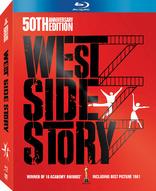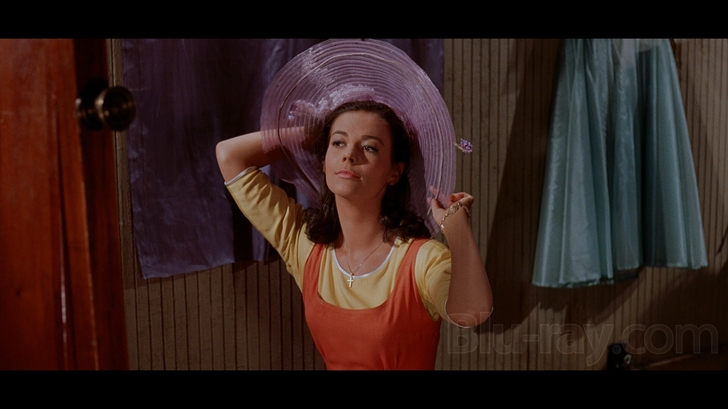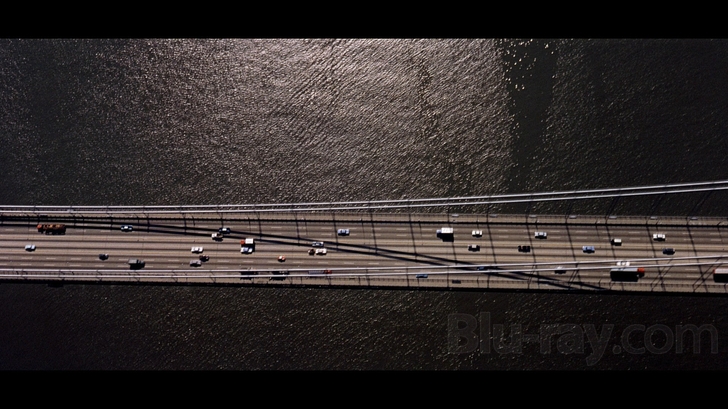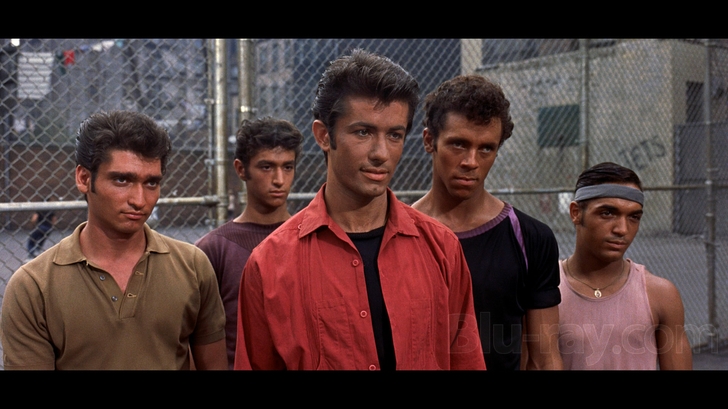West Side Story Blu-ray Movie
HomeWest Side Story Blu-ray Movie 
Limited 50th Anniversary Edition / Blu-ray + DVD + CDMetro-Goldwyn-Mayer | 1961 | 154 min | Not rated | Nov 15, 2011

Movie rating
7.9 | / 10 |
Blu-ray rating
| Users | 4.5 | |
| Reviewer | 4.0 | |
| Overall | 4.0 |
Overview
West Side Story (1961)
Two youngsters from rival New York City gangs fall in love, but the doomed lovers are caught up in the violence of rival street gangs.
Starring: Natalie Wood, Richard Beymer, Russ Tamblyn, Rita Moreno, George ChakirisDirector: Robert Wise (I), Jerome Robbins
| Romance | Uncertain |
| Musical | Uncertain |
| Drama | Uncertain |
| Teen | Uncertain |
| Crime | Uncertain |
Specifications
Video
Video codec: MPEG-4 AVC
Video resolution: 1080p
Aspect ratio: 2.19:1
Original aspect ratio: 2.20:1
Audio
English: DTS-HD Master Audio 7.1 (48kHz, 24-bit)
French: DTS 5.1
Spanish: Dolby Digital 5.1 (448 kbps)
German: DTS 5.1
English: Dolby Digital 4.0
Subtitles
English SDH, French, German, Portuguese, Spanish, Danish, Dutch, Finnish, Mandarin (Simplified), Norwegian, Swedish
Discs
50GB Blu-ray Disc
Four-disc set (2 BDs, 1 DVD, 1 CD)
DVD copy
Packaging
Slipcover in original pressing
Playback
Region free
Review
Rating summary
| Movie | 4.5 | |
| Video | 4.0 | |
| Audio | 4.0 | |
| Extras | 4.0 | |
| Overall | 4.0 |
West Side Story Blu-ray Movie Review
Will this be just any Blu-ray?
Reviewed by Jeffrey Kauffman November 8, 2011It’s somewhat hard to believe, especially considering the work’s present day reputation in both its stage and film incarnations, but West Side Story was more of a succès d’estime than an outright smash when it opened on Broadway in 1957. It was certainly appreciated critically (for the most part, though even the critics had some qualms), and it managed a respectable if not earth shattering run (certainly much longer than Bernstein’s 1956 musical Candide had), but it was really the 1961 Robert Wise film that seemed to reinvigorate the property and made it into the icon it is today. (It is worth noting that the 1957 Tony for Best Musical actually went to The Music Man, and West Side Story only won a couple of relatively minor technical awards). 1961 audiences had never seen a film quite like West Side Story before, and it seemed to perfectly capture both the hope and the unseemly underbelly of the New Frontier era, becoming a cinematic zeitgeist that is still viscerally felt now fifty years after its release. The soaring Bernstein score, the incredible use of location photography by director Robert Wise, the unbelievably athletic choreography by Jerome Robbins (credited as co-director of the film), the innovative titles created by Saul Bass, all seemed incredibly innovative and stand as some of the finest examples of musical filmmaking in the entire annals of cinema. The film was an immediate sensation when it was released, the original soundtrack album on Columbia Records vaulted to the top of the charts (where it stayed for over a year), songs from the score which had been well received but hardly considered standards were suddenly Top 10 hits (“Tonight” by Ferrante and Teicher, etc.), and the whole world seemed to be entranced by this modern day reworking of Shakespeare’s Romeo and Juliet, set amid the tenements of New York City and dealing with the tensions not between the Montagues and Capulets, but between Anglos and Puerto Ricans.

To begin to understand just how revolutionary West Side Story was when it debuted, it’s instructive to look back at the previous behemoth musical which brought home a record setting number of Oscars, including Best Picture, 1958’s Gigi. Gigi was the apotheosis of everything that the M-G-M musical had striven to be for over two decades: big, colorful, lush and tuneful. It was also decidedly old-fashioned, purposefully so, and even its most potentially controversial aspect—that young Gigi was in training to be a courtesan—was handled with a circumspection befitting the Eisenhower age. Now simply take a look at the opening fifteen minutes of West Side Story to see how radically Robert Wise, Jerome Robbins and the entire creative crew of the film rethought the entire cinematic experience of the musical. After that ultramodern Saul Bass title design which plays out against the film’s bristing Overture, we get a quarter hour of virtually nothing but Bernstein’s propulsive Prologue and dance, all shot on location in Manhattan amongst the rubble of what would soon become Lincoln Center. The film begins with amazing aerial shots of Manhattan looking straight down on the city and far away traffic noises can be heard as Bernstein’s glorious music begins playing. The film immediately thrust the viewer in an alternate reality where, yes, rival gang members danced—and danced ballet- like moves at that—and it was all not just believable, it was viscerally palpable.
It’s that incredible dance element which is probably West Side Story’s most distinctive element and while the creative difference between Robert Wise and Jerome Robbins are well documented, Robbins’ contributions cannot be underestimated. Frankly, neither can Wise’s, for it was no doubt Wise’s directorial acumen as well as his history with editing that shaped the film so brilliantly. Has anyone ever used a zoom lens as potently (and minimally, thank heavens) as Wise does in that opening shot of the Jets? Has any other musical blended movement, editing and music so seamlessly as has West Side Story? (About the only close analog I can think of, and it’s a distant second, is the brilliant editing of “Tradition” in Fiddler on the Roof). While some of the film may in fact seem slightly creaky today, especially with regard to the not all that threatening interplay between the Jets and Sharks, at least in the opening scenes, West Side Story still maintains a vigor and energy which is startling to this day. And pay attention to how many long takes are used in the film, despite its brilliant editing. This is not Chicago-style quick cutting where the viewer is fooled into thinking they’re seeing brilliant dance. This is brilliant dance, caught on film as it never had been before and frankly never has since.
The other amazing element at the forefront of this film is the incredible music of Leonard Bernstein, delivered here in sumptuous orchestrations by a wealth of incredible talents including Johnny Green, Sid Ramin, Irwin Kostal and Saul Chaplin (who also associate produced). It’s fascinating to realize that Bernstein, ever the charming pedant, took history’s most notorious interval, the augmented fourth (or diminished fifth), the Diabolus in musica or tritone, long considered unsingable, and built an entire score around it. It’s indicative of how well he achieved his goal that generations of college music theory students have since learned to recognize the tritone with the mnemonic device of the opening two notes of “Maria” from West Side Story. This is one of the most symphonic and operatic “musical” scores in the annals of Broadway and/or Hollywood, and it is a score filled with such genius and impeccable musicianship that it has lost none of its allure and gut-wrenching power in the more than half century since audiences first heard it on the Great White Way.
Richard Beymer has come in for fairly consistent critical brickbats for his ultra-“nice boy” Tony, but his performance is filled with the naïvete of the early sixties, an idealism and hope that may strike cynical 21st century types as hopelessly old fashioned but which was then in full flower. The rest of the cast can’t be faulted under any circumstances. Natalie Wood is a beautiful and, in the film’s tragic denouement, haunting Maria, and Oscar winners Rita Moreno and George Chakiris are fiery and unforgettable as Anita and Bernardo. The supporting cast is filled with fantastic turns by everyone from Russ Tamblyn as Riff, a very funny John Astin as the high school’s dance organizer, and Ned Glass as the world weary Doc, owner of the neighborhood malt shop where the Jets meet to work on their plans to defeat the Sharks.
West Side Story is perhaps the prime example of how to adapt a stage musical to the medium of film. Several very smart alterations were made to the placement of songs in a different order from the Broadway version, and Wise and his crew took advantage of every technical bell and whistle then at their disposal without ever making the film seem gimmicky or fake. Everything from the glorious location footage of the opening to the amazing abstract dissolve of Maria twirling into the high school dance sequence to Boris Leven’s stunning production design which makes New York a claustrophobic calamity, work in perfect harmony here, making this one of the true glories of 20th century film. If you’ve never seen West Side Story, you’re in for one of the prime experiences of your film-going life. If you have seen West Side Story and are eagerly awaiting its Blu-ray debut, pull up a chair and put in your disc, sit back and enjoy, for tonight will most definitely not be just any night.
West Side Story Blu-ray Movie, Video Quality 

Fans of West Side Story's AVC encoded 1080p transfer in 2.19:1 have ben abuzz with some pretty venomous
comments based on some early reports of flaws with this presentation, and several have decided before even seeing the
Blu-ray that it's not worth owning. Are there problems? Yes, certainly, at least one of which should never have
happened under any circumstances. Other compression artifacts, while troubling, are fairly commonplace ones that
videophiles have seen in manifold high definition presentations since the dawn of the Blu-ray age. So let's get the bad
out of the way first, and the good news (if bad news is ever good news) is that the bulk of the problems with West
Side Story happen in the first few minutes. The inexcusable error is the absolutely incomprehensible and
dunderheaded fade-out and fade-in during Saul Bass's iconic title design which accompanies the Overture. Fans of the
film know that there should be no fade out whatsoever, simply a bold color change, followed by the slight pull back which
reveals the title West Side Story as part of Bass's abstract skyline. That error was embarrassing enough
for Fox to immediately agree to a second pressing, and corrected discs are expected soon (we'll make sure to post any
exchange information in our news section as it becomes available). As we progress through the actual opening of the
film, the overhead shots of Manhattan are plagued by fairly abhorrent shimmer on lots of the vertical lines of the
skyscrapers. Later even more outrageous shimmer, verging on actual moiré at times, repeatedly hits the fence in the
basketball court where the Jets and Sharks have their showdown (especially egregious examples can be seen at 7:43
and 11:53). Gated windows exhibit the same artifacting, notably at around 8:22. Very slight shimmer is also noticeable
on the ribbed orange wall paneling of the high school dance scene later in the film. There are also some registration
issues with opticals throughout the film, where density seems slightly affected.
So that's the bad news. The good news may not sound as dramatic, but it's really rather amazing. I have seen this
film repeatedly in 70mm (and 35mm) through the years, and I can honestly say it has never looked this sharp or
appealing, despite the occasional flaws of this transfer. Colors are gorgeously saturated, everything that an early
sixties Technicolor film should be. Those outrageous reds and purples of Bernardo's shirt have never popped so
magnificently, and everything from the weird oranges and purples of the high school dance sequence to that similarly
orange hued semi-nightmare scene in Anita's apartment late in the film have never looked this gorgeous. West Side
Story has been touted as having undergone hundreds of hours of restoration, and while that may or may not be PR
hyperbole, the fact is this presentation is absolutely blemish free, clear and clean and remarkably sharp and well
detailed.
In my personal opinion, the pluses far outweigh the minuses of this presentation and once Fox offers replacements fixing
the Overture debacle, at least one major complaint will have been dealt with. Is this a perfect presentation? No, and I'm
the first to say it certainly could have been better. Fox hasn't quite attained the generally consistent excellence
that
Warner has with their catalog titles (at least with regard to M-G-M and United Artists), and while Warner efforts like
their recent
Mutiny on the Bounty and now Fox's West Side Story are not all they might have been, there's still an
awful lot
here to celebrate.
West Side Story Blu-ray Movie, Audio Quality 

Was there another missed opportunity with regard to West Side Story's new lossless DTS-HD Master
Audio 7.1 mix? That depends on whom you ask. The film's original six track mag masters were discovered and restored
last year, but those were not used for this new mix, evidently due to cost considerations. Instead a repurposing of the
four track mag masters was considered more feasible. There's a fascinating article audiophiles may want to read here which details the discovery and history of the six
track mix, which was standard in the Todd-AO format. Be that as it may, once again Fox has at least slightly missed the
surround boat with this new rendering, and once again the biggest problem comes right off the bat, in terms of the iconic
whistles which open the film. While they still are panned more toward the rear in this mix, they're not panned to the
extreme side channels (alternating left and right) as they were in the original mix. With both this error and the
unforgivable fade out on the Overture it's apparent that Fox either incomprehensibly didn't use a reference print of any
kind or simply didn't have anyone working on this film who had any history or knowledge of how it was presented
theatrically. The brouhaha raised by these errors will hopefully be a major wake up call to creative staffs who are
working on Blu-ray releases of iconic catalog properties, as there are copious quantities of people still around who
do have histories with the film, at the very least as audience members, and they remember how these
movies looked and sounded.
And so once again, we're over the bad news. The good news is the 7.1 repurposing is for the most part rather artful.
While highs seem to be just slightly clipped on this track, for the most part the music sounds absolutely gorgeous, with
sterling fidelity and amazing dynamic range. Surround activity, aside from those opening whistles, is very well handled,
and such great scenes as the Quintet have singing coming in clearly from the surrounds, helping to separate and define
the many participants. Best of all, the last incomprehensible thing that happened on a West Side Story
home video release, the bizarre audio synch problem during "Tonight," has been corrected. (What is it with these star-
crossed home video releases of West Side Story, anyway?).
West Side Story Blu-ray Movie, Special Features and Extras 

- Pow! The Dances of West Side Story (HD; 19:12) can either be accessed as in-movie supplements via seamless branching or played on their own. The many iconic dance sequences are analyzed by such talking heads as Robert Relyea, Assistant Director of West Side Story, Jamie Bernstein (Leonard Bernstein's daughter), Yvonne Wilder, who played Consuelo in the film, as well as others less connected to the film, including everyone from Debbie Allen to Mikhail Baryshnikov.
- Song Specific Commentary by Stephen Sondheim. Sondheim has long harangued himself over some of his lyrics for West Side Story, and he does so again here, repeating some of the same anecdotes he relates in accompanying featurettes. We still love you, Steve.
- Music Machine (HD; 1:25:07) is a video jukebox of all the film's musical sequences. Each song/sequence can also be accessed individually.
- A Place for Us: West Side Story's Legacy (1080i; 29:28) is a decent if occasionally kind of silly retrospective documenting the film's cultural impact. When you get everything from Baryshnikov to The Fantastic Mr. Fox, things are by their very nature highly variable, but it's great to hear from Sondheim and some of the actors in the 1961 film recount their memories and what the film meant to them personally and professionally.
- West Side Memories (SD; 55:55) is an older featurette offering archival recordings of Jerome Robbins, as well as reminiscences by original Book writer Arthur Laurents, lyricist Sondheim, director Hal Prince and a wealth of people involved in the motion picture version. The problems which ensued between Jerome Robbins and Robert Wise are recounted and are quite interesting.
- Storyboard to Film Comparison Montage (SD; 4:50)
- Trailers (HD; 11:50). (If you want a great example of just how great the new transfer looks in general terms, compare it to the first theatrical trailer shown in this collection, especially with regard to color).
- Tribute CD contains covers of the score's iconic songs by such artists as Charlotte Church, Dave Grusin, Maynard Ferguson and Julie Andrews.
- Hardcover Book has lots of photos and an Introduction by Producer Walter Mirisch.
- Reproductions of International Posters on Postcards
West Side Story Blu-ray Movie, Overall Score and Recommendation 

Is this a perfect West Side Story? No. There are troubling, if overall minor, issues with both the video and audio presentations. Should that keep collectors from wanting this release? The internet hubbub has already caught Fox's attention and it seems likely now that at the very least the Overture debacle will be quickly handled. The compression artifacts are another issue, but the good news is for the most part they're over with after the first few minutes of the film. The misplaced whistles will probably bother those with long memories the most, and those are at least partially offset by finally having "Tonight" in synch. In my personal opinion, this really isn't a glass half full, glass half empty debate. The pluses of this release far outweigh the troubling minuses. The color, detail and clarity of this presentation are for the most part amazing, and the soundtrack, even sourced from four track mags instead of six, sounds wonderful. This set comes with some decent supplements as well. Some may want to wait until Fox officially announces an exchange program, but taken as a whole (and with the caveats mentioned above, which may affect any individual's response to the release), West Side Story comes Highly recommended.
Other editions
West Side Story: Other Editions

West Side Story
50th Anniversary Edition
1961

West Side Story
50th Anniversary Edition
1961

West Side Story
50th Anniversary Edition
1961

West Side Story
MGM 90th Anniversary Edition
1961

West Side Story
50th Anniversary Edition
1961

West Side Story
1961

West Side Story 4K
1961
Similar titles
Similar titles you might also like

Rent
2005

Gentlemen Prefer Blondes
1953

Show Boat
Warner Archive Collection
1951

A Star Is Born
1954

There's No Business Like Show Business
1954

Nine
2009

The Last Five Years
2014

Brooklyn
2015

Across the Universe
2007

The King and I
1956

Pal Joey
1957

Absolute Beginners
1986

Burlesque
2010

It's Always Fair Weather
Warner Archive Collection
1955

Cabaret
Reissue
1972

Yentl
Limited Edition to 3000 - SOLD OUT
1983

Dirty Dancing: Havana Nights
2004

Young at Heart
1954

Ziegfeld Girl
Warner Archive Collection
1941

Moulin Rouge!
2001